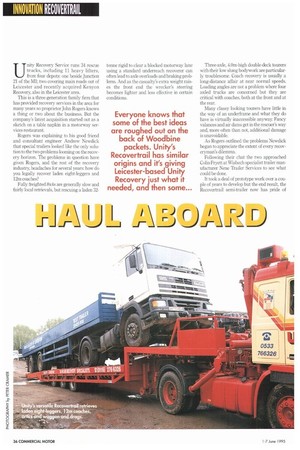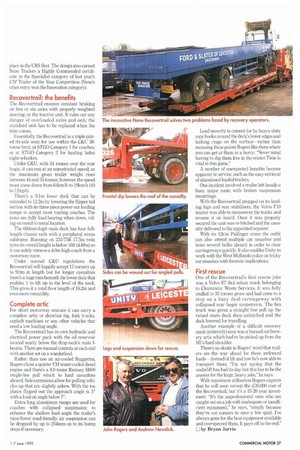U nity Recovery Service runs 34 rescue trucks, including 11 heavy
Page 48

Page 49

If you've noticed an error in this article please click here to report it so we can fix it.
lifters, from four depots: one beside Junction 21 of the Ml; two covering main roads out of Leicester and recently acquired Kenyon Recovery, also in the Leicester area.
This is a three-generation family firm that has provided recovery services in the area for many years so proprietor John Rogers knows a thing or two about the business. But the company's latest acquisition started out as a sketch on a table napkin in a motorway services restaurant.
Rogers was explaining to his good friend and consultant engineer Andrew Newdick that special trailers looked like the only solution to the two problems looming on the recovery horizon. The problems in question have given Rogers, and the rest of the recovery industry, headaches for several years: how do you legally recover laden eight-leggers and 12m coaches?
Fully freighted 8x4s are generally slow and fairly local retrievals, but rescuing a laden 32 tonne rigid to clear a blocked motorway lane using a standard underreach recoverer can often lead to axle overloads and braking problems. And as the casualty's extra weight raises the front end the wrecker's steering becomes lighter and less effective in certain conditions. Three-axle, 4.0m.high double-deck tourers with their low slung bodywork are particularly troublesome. Coach. recovery is usually a long-distance affair at near normal speeds. Loading angles are not a problem where four axled trucks are concerned but they are critical with coaches, both at the front and at the rear.
Many classy looking tourers have little in the way of an underframe and what they do have is virtually inaccessible anyway. Fancy valances and air dams get in the rescuer's way and, more often than not, additional damage is unavoidable.
As Rogers outlined the problems Newdick began to appreciate the extent of every recoveryman's dilemma.
Following their chat the two approached ColMFryett at Wisbech specialist trailer manufacturer Nene Trailer Services to see what could be done.
It took a deal of prototype work over a couple of years to develop but the end result, the Recovertrail semi-trailer now has pride of place in the URS fleet. The design also earned Nene Trailers a Highly Commended certificate in the Specialist category of last year's CM Trailer of the Year Competition (Nene's other entry won the Innovation category).
Recovertrail: the benefits
The Recovertrail ensures constant braking on five or six axles with properly weighted steering on the tractive unit. It rules out any danger of overloaded axles and only the standard unit has to be replaced when the time comes.
Essentially the Recovertrail is a triple plated tri-axle semi for use within the C&U 38tonne limit; at STGO Category 1 for coaches; or at STGO Category 2 for hauling laden eight-wheelers.
Under C&U, with 24 tonnes over the rear bogie, it can run at an unrestricted speed; as the maximum gross trailer weight rises between 44 and 55 tonnes, however, the speed must come down from 64kinJh to 19km/h (40 to 12mph).
There's a 9.1in lower deck that can be extended to 12.2m by lowering the flipper tail section with its three-piece power-out loading ramps to accept most touring coaches. The rams are fully load-bearing when down, riding on metal to metal location.
The 660mm-high main deck has four fulllength chassis rails with a peripheral stress subframe. Running on 235/75R 17.5in twin tyres its overall height is below 16ft (4.88m) so it can safely retrieve a 4.0m-high coach from a motorway route.
Under normal C&U regulations the Recovertrail will happily accept 17-tonners up to 9.0m in length but for longer casualties there's a huge ram beneath the lower deck that enables it to tilt up to the level of the neck. This gives it a total floor length of 16.2m and even more versatility
Complete artic
For short motorway rescues it can carry a complete artic or drawbar rig, fork trucks, asphalt machines or any other vehicles that need a low loading angle.
The Recovertrail has its own hydraulic and electrical power pack with the oil reservoir located neatly below the drop neck's main Ibeams There are manual controls at each end with another set on a wanderlead.
Rather than use an air-cooled Ruggerini, Rogers chose a quieter VN1 water-cooled diesel engine and there's a 9.0 tonne Ramsey H800 single-line pull winch to haul casualties aboard. Side extensions allow for pulling vehicles up that are slightly askew. With the toe plates flipped out the approach angle is 50 with a load-on angle below 70
Extra long aluminium ramps are used for coaches with collapsed suspension: to enhance the shallow load angle the trailer's raise/lower road-friendly air suspension can be dropped by up to 254mm on to its bump stops if necessary. Load 'security is catered for by heavy-duty rope hooks around the deck's lower edges and lashing rings on the surface—rather than recessing these points Rogers like them where you can get at them in a hurry: 'Never mind having to dig them free in the wintenTime is vital in this game."
A number of unexpected benefits became apparent in service, such as the easy retrieval of abandoned loaded trailers.
One incident involved a trailer left beside a busy major route with broken suspension mountings.
With the Recovertrail propped on its landing legs and rear stabilisers, the Volvo F10 tractor was able to manoeuvre the trailer and reverse it on board. Once it was properly secured the unit was re-hitched and the casualty delivered to the appointed repairer.
With its 12t/rn Palfinger crane the outfit can also attend multiple car smashes and hoist several hulks aboard in order to clear carriageways quickly It also enables Unity to work with the West Midlands police on tricky car smashes with forensic implications.
First rescue
One of the Recovertrail's first rescue jobs was a Volvo F7 8x4 refuse truck belonging to Cleanaway Waste Services, It was fully stuffed to 32 tonnes gross and had conic to a stop on a busy dual carriageway with collapsed rear bogie suspension. The bin truck was given a straight line pull up the raised main deck then unhitched and the deck lowered for travelling.
Another example of a difficult recovery made (relatively) easy was a burned out brewery artic which had to be picked up from the MI's hard shoulder.
There's no doubt in Rogers' mind that trailers are the way ahead for these awkward loads instead of lift and tow he's now able to transport them: "I'm not saying that the underlift has had its day but this has to be the answer for the large, heavy jobs," he says.
With maximum utilisation Rogers expects that he will soon recoup the £30,000 cost of the Recovertrail, but it's a 15-20 year investment: "It's the unprofessional ones who are caught out on a job with inadequate or insufficient equipment," he says, "simply because they've cut corners to save a few quid. I've always gone for the best equipment available and overspecced them. It pays off in the end."
by Bryan Jarvis








































































































